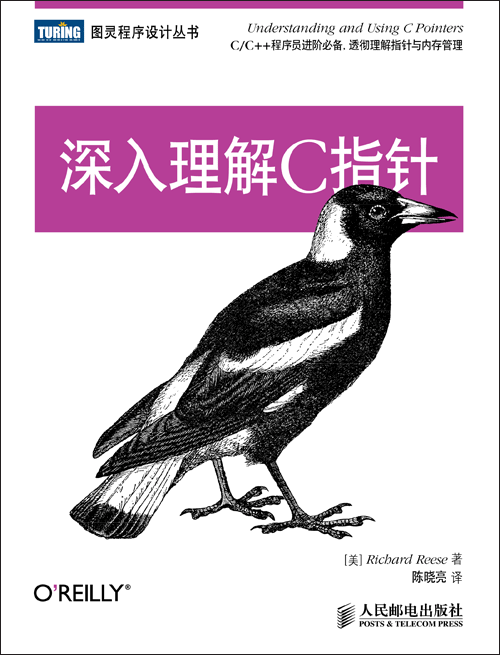学习使用C指针(影印版)
出版时间:2013年12月
页数:208
通过对C指针和内存管理的扎实理解来提高你的编程技能。在这本贴合实际的书籍里,你将了解到指针是如何提供了相应的机制来动态操纵内存,增强对数据结构的支持,允许直接访问硬件。作者Richard Reese通过本书中的内存模型为你展示了如何在数组、字符串、结构和函数中使用指针。
虽然难以掌握,但是指针为C语言提供了灵活性和强大能力,不过很少有资料来讲述这种数据类型。无论你是初学者还是有经验的C或者C++编程人员和开发者,这本详尽的书籍都有着你所需要的知识。
· 获得针对指针的介绍,包括不同指针类型的定义
· 了解动态内存分配、释放和改变内存管理技巧
· 使用把数据传入函数或者从函数中返回数据的技术
· 理解运用指针时数组的基本特性
· 探索字符串的基本知识以及如何使用指针来支持字符串
· 探讨为什么指针会导致安全问题,比如缓冲区溢出问题
· 了解多种指针技术,诸如不透明指针、有界指针和restrict关键字
Richard Reese是位于德克萨斯州斯蒂芬维尔镇上的塔尔顿州立大学的副教授。他在工业界和教育界工作了三十多年,包括在洛克希德马丁公司从事了十年的软件开发支持工作。
虽然难以掌握,但是指针为C语言提供了灵活性和强大能力,不过很少有资料来讲述这种数据类型。无论你是初学者还是有经验的C或者C++编程人员和开发者,这本详尽的书籍都有着你所需要的知识。
· 获得针对指针的介绍,包括不同指针类型的定义
· 了解动态内存分配、释放和改变内存管理技巧
· 使用把数据传入函数或者从函数中返回数据的技术
· 理解运用指针时数组的基本特性
· 探索字符串的基本知识以及如何使用指针来支持字符串
· 探讨为什么指针会导致安全问题,比如缓冲区溢出问题
· 了解多种指针技术,诸如不透明指针、有界指针和restrict关键字
Richard Reese是位于德克萨斯州斯蒂芬维尔镇上的塔尔顿州立大学的副教授。他在工业界和教育界工作了三十多年,包括在洛克希德马丁公司从事了十年的软件开发支持工作。
- Chapter 1: Introduction
- Pointers and Memory
- Pointer Size and Types
- Pointer Operators
- Common Uses of Pointers
- Summary
- Chapter 2: Dynamic Memory Management in C
- Dynamic Memory Allocation
- Dynamic Memory Allocation Functions
- Deallocating Memory Using the free Function
- Dangling Pointers
- Dynamic Memory Allocation Technologies
- Summary
- Chapter 3: Pointers and Functions
- Program Stack and Heap
- Passing and Returning by Pointer
- Function Pointers
- Summary
- Chapter 4: Pointers and Arrays
- Quick Review of Arrays
- Pointer Notation and Arrays
- Using malloc to Create a One-Dimensional Array
- Using the realloc Function to Resize an Array
- Passing a One-Dimensional Array
- Using a One-Dimensional Array of Pointers
- Pointers and Multidimensional Arrays
- Passing a Multidimensional Array
- Dynamically Allocating a Two-Dimensional Array
- Jagged Arrays and Pointers
- Summary
- Chapter 5: Pointers and Strings
- String Fundamentals
- Standard String Operations
- Passing Strings
- Returning Strings
- Function Pointers and Strings
- Summary
- Chapter 6: Pointers and Structures
- Introduction
- Structure Deallocation Issues
- Avoiding malloc/free Overhead
- Using Pointers to Support Data Structures
- Chapter 7: Security Issues and the Improper Use of Pointers
- Pointer Declaration and Initialization
- Pointer Usage Issues
- Memory Deallocation Issues
- Using Static Analysis Tools
- Summary
- Chapter 8: Odds and Ends
- Casting Pointers
- Aliasing, Strict Aliasing, and the restrict Keyword
- Threads and Pointers
- Object-Oriented Techniques
- Summary
书名:学习使用C指针(影印版)
作者:Richard Reese 著
国内出版社:东南大学出版社
出版时间:2013年12月
页数:208
书号:978-7-5641-4603-0
原版书书名:Understanding and Using C Pointers
原版书出版商:O'Reilly Media
The animal on the cover of Understanding and Using C Pointers is the piping crow-shrike,or Australian magpie (Cracticus tibicen). Not to be confused with the piping crow found in Indonesia, the Australian magpie is not a crow at all; it is related to butcherbirds and is native to Australia and southern New Guinea. There were once three separate species of Australian magpie, but interbreeding has resulted in the coalescence of their three species into one.
Australian magpies have black heads and bodies with varied black and white plumage on their backs, wings, and tails. The Australian magpie is also called the piping crowshrike due to its multi-tonal, complex vocalizations. Like true crows, the Australian magpie is omnivorous, though it prefers to eat insect larvae and other invertebrates. It lives in groups of up to two dozen, and all members generally defend the group territory.
During springtime, however, some breeding males will become defensive of their nests and will engage in swooping attacks on passersby, including human and their pets.
This magpie is a non-migratory bird and has adapted to human environments, as well as to a mix of forested and open areas. For that reason, it is not endangered, and although it is considered a pest species in neighboring New Zealand, the magpie may be very useful in Australia for keeping the invasive cane toad in check. When introduced to Australia, the cane toad had no natural predators, and its toxic secretions ensured the multiplication of its numbers. However, the highly intelligent magpie has learned to flip over the cane toad, pierce its underbelly, and use its long beak to eat the toad’s organs, thus bypassing the poisonous skin. Researchers are hopeful that the Australian magpiewill become a natural predator of the cane toad and aid in population control.
Australian magpies have black heads and bodies with varied black and white plumage on their backs, wings, and tails. The Australian magpie is also called the piping crowshrike due to its multi-tonal, complex vocalizations. Like true crows, the Australian magpie is omnivorous, though it prefers to eat insect larvae and other invertebrates. It lives in groups of up to two dozen, and all members generally defend the group territory.
During springtime, however, some breeding males will become defensive of their nests and will engage in swooping attacks on passersby, including human and their pets.
This magpie is a non-migratory bird and has adapted to human environments, as well as to a mix of forested and open areas. For that reason, it is not endangered, and although it is considered a pest species in neighboring New Zealand, the magpie may be very useful in Australia for keeping the invasive cane toad in check. When introduced to Australia, the cane toad had no natural predators, and its toxic secretions ensured the multiplication of its numbers. However, the highly intelligent magpie has learned to flip over the cane toad, pierce its underbelly, and use its long beak to eat the toad’s organs, thus bypassing the poisonous skin. Researchers are hopeful that the Australian magpiewill become a natural predator of the cane toad and aid in population control.
购买选项
